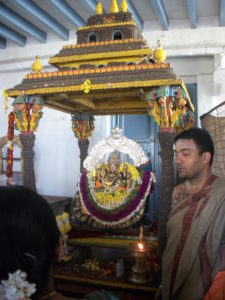You need not have eyes to find spirituality in India. It is everywhere. You can hear it – in the Vedic chants streaming eerily from the robed men and women walking along the 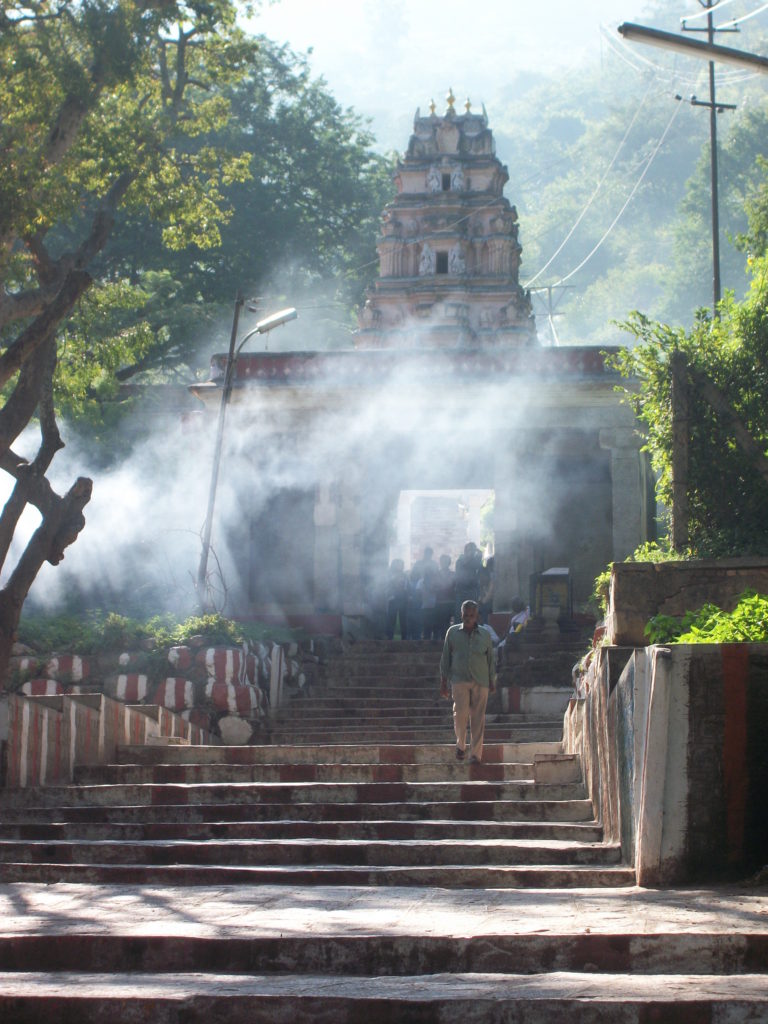 streets at pre-dawn, or in the conch shells bellowing during a religious ceremony; you can smell it – in the incense, cow dung, and oils burning inside temples and shrines; you can feel it – in the hands of the pujari, or priest, as he takes your offering and marks your forehead with a vermilion tilaka; you can taste it – in the spicy richness of the dals and curries, the freshness of the papayas, pomegranates, and pineapples, all of which have been prayed over by the farmer who grew and sold his crop, his livelihood. Even if you’re not a spiritual person you will feel it because it surrounds, engulfs you.
streets at pre-dawn, or in the conch shells bellowing during a religious ceremony; you can smell it – in the incense, cow dung, and oils burning inside temples and shrines; you can feel it – in the hands of the pujari, or priest, as he takes your offering and marks your forehead with a vermilion tilaka; you can taste it – in the spicy richness of the dals and curries, the freshness of the papayas, pomegranates, and pineapples, all of which have been prayed over by the farmer who grew and sold his crop, his livelihood. Even if you’re not a spiritual person you will feel it because it surrounds, engulfs you.
I had only been in India for a little over a week when, after a 6 a.m. intensive and very sweaty ashtanga yoga practice, I and three other yogis decided to climb the 1,001 stairs of Chimundi Hill. I had read about Chimundi Hill in my India travel book and knew that it held some of the most beautiful views of Mysore, India, where I was living for six weeks while practicing yoga. So we grabbed an auto-rickshaw driver, picked up his eight-year-old son, and the six of us packed into the rickshaw and went through the city on a 20-minute ride to Chimundi Hill. What a beautiful morning for a hike!
I wasn’t sure what to expect, nor did I even try to guess, as my eyes have been bewildered and my mind blown several thousand times over in the short time since I’d been in Mysore. But I did assume that we were going on a hike, up a hill, and that should be nothing too out of the ordinary. But India is anything but ordinary.
When we arrived at the bottom of the 1,000 stairs up the hill, my jaw dropped once more. Mystical is the only word to describe it. There was still an early morning fog sweeping before a towering ornamental entryway to the stairs of the hill. Or, wait – maybe it was smoke or incense swinging past the towering gate? Whatever it was, the morning just became mystical.
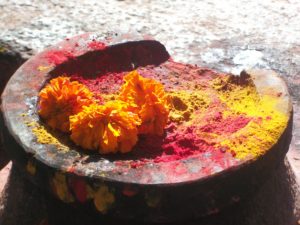 I wasn’t sure if the tower was a gate or a temple at first. It was shaped sort of like a Hindu temple, with progressively smaller pavilions stacked on one another and ornate carvings of deities dancing and posing their way to the top, which must have been 60 feet high. I noticed there were monkeys fluttering about the entryway and my attention turned to them.
I wasn’t sure if the tower was a gate or a temple at first. It was shaped sort of like a Hindu temple, with progressively smaller pavilions stacked on one another and ornate carvings of deities dancing and posing their way to the top, which must have been 60 feet high. I noticed there were monkeys fluttering about the entryway and my attention turned to them.
Monkeys! It was then that I realized, “I am in a foreign land and this is going to be no hike like I’ve ever experienced.” My senses were consumed with so many interesting sights and smells. I think I heard chanting. And birds I’ve never heard before cooing. And monkeys… making monkey noises!
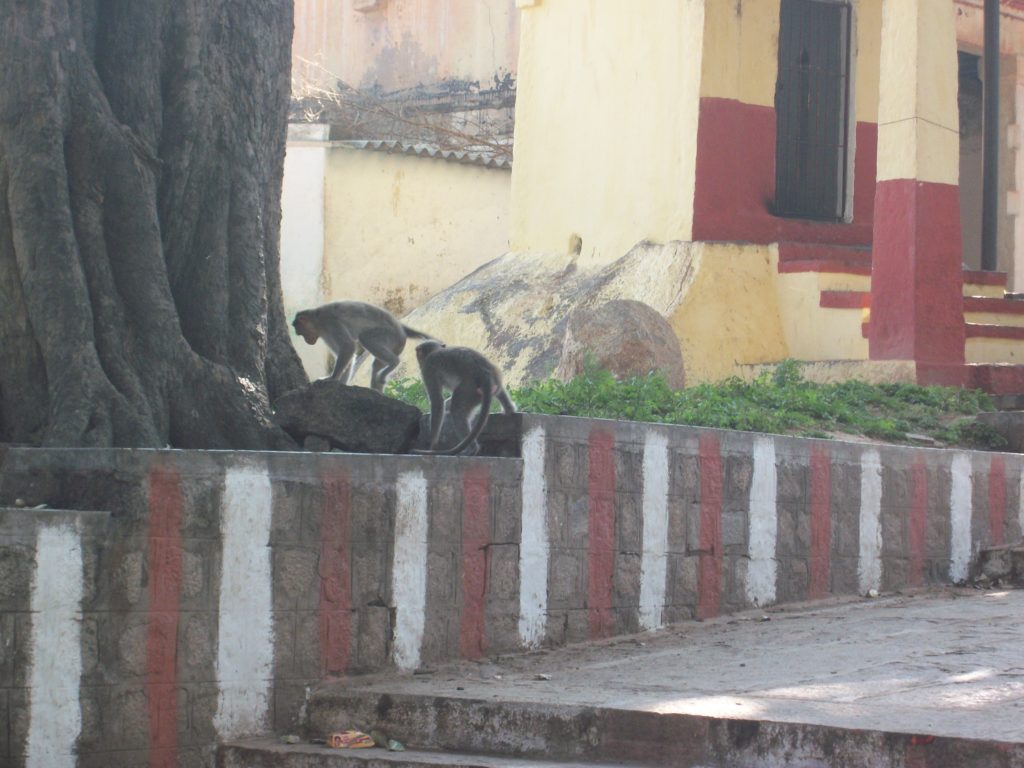 As we walked up the ancient steps made of layers of big rocks (I suppose being built in 1664 makes them “ancient”), I noticed that some of the risers of the stairs, also made of stone, were painted in red and white stripes. Indians must have tired of the boring gray stones after 352 years and decided to spruce them up a bit. Nothing in this country deserves to be without color, especially not sacred steps.
As we walked up the ancient steps made of layers of big rocks (I suppose being built in 1664 makes them “ancient”), I noticed that some of the risers of the stairs, also made of stone, were painted in red and white stripes. Indians must have tired of the boring gray stones after 352 years and decided to spruce them up a bit. Nothing in this country deserves to be without color, especially not sacred steps.
Just past the gate and before the beginning of the stairs there was a broken bowl-ish type of container that may have also been 352 years old. It was filled with bright red and yellow powder, with three yellow flowers lying on top. “What is this used for?” I asked my friend Kristina. “For praying, to put on your forehead,” she said. Of course.
 We continued up the stairs in the crisp morning air, quickly noticing that not every step was of the same length. Some steps were only four or five inches high, while others may have been 18 inches high. We wondered what we were thinking, embarking on a one-hour hike after two hours of intense yoga. We began to keep a slower pace, taking in the brilliant views. And trying not to get out of breath.
We continued up the stairs in the crisp morning air, quickly noticing that not every step was of the same length. Some steps were only four or five inches high, while others may have been 18 inches high. We wondered what we were thinking, embarking on a one-hour hike after two hours of intense yoga. We began to keep a slower pace, taking in the brilliant views. And trying not to get out of breath.
There were shrines along the way. Shrines for Hanuman, Lakshmi, Ganesh, and Shiva, and other Hindu deities to see to it that we had a good journey. Many, sadly, were covered in graffiti.
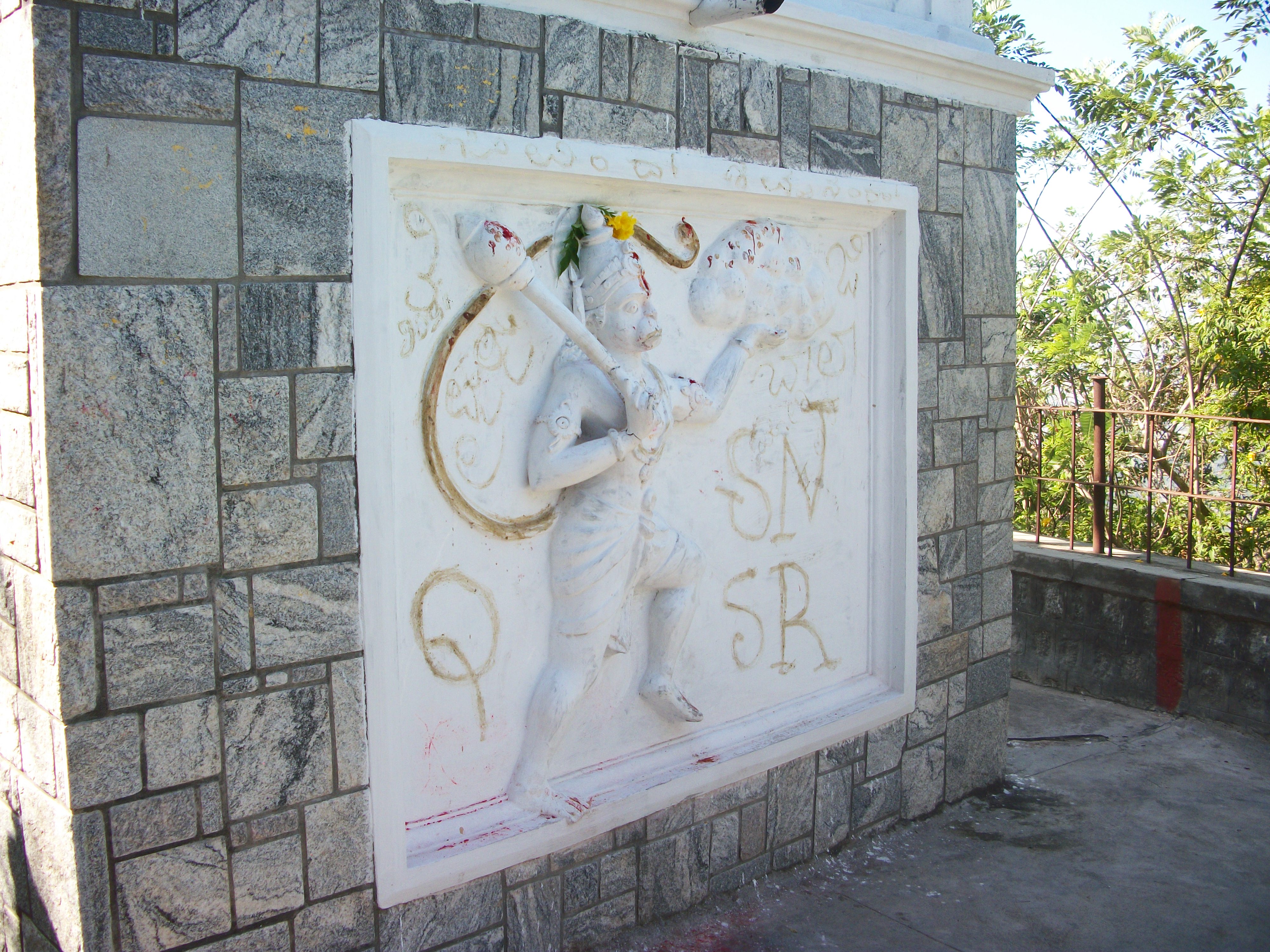
There were other people making this trek, mostly Indians but some foreigners. We passed a beggar woman holding out her hand to us, a black dog asleep beside her. Her eyes were tired. Other people were sweeping debris off of the steps and asking for a few rupees in exchange for their labor.
India is full of so many colors, and so much beauty, on one hand. It is filled with layer upon layer of the many colors of flowers, fruits, lentils, spices, saris, bindis, Gods, deities, and aromas. On the other hand, there is garbage everywhere, dirty children holding out their hands and pointing to their mouths. It is filled with much poverty and sadness, keeping things deep and real, and extreme at all times.
We stopped along the way for some fresh pineapple pieces from a man selling them along the road. We noticed a group of people wearing all-white jogging suits that read(in red) “Postal Training Centre, Mysore” on their backs. So that’s how the postal workers get in shape – they climb Chimundi Hill!
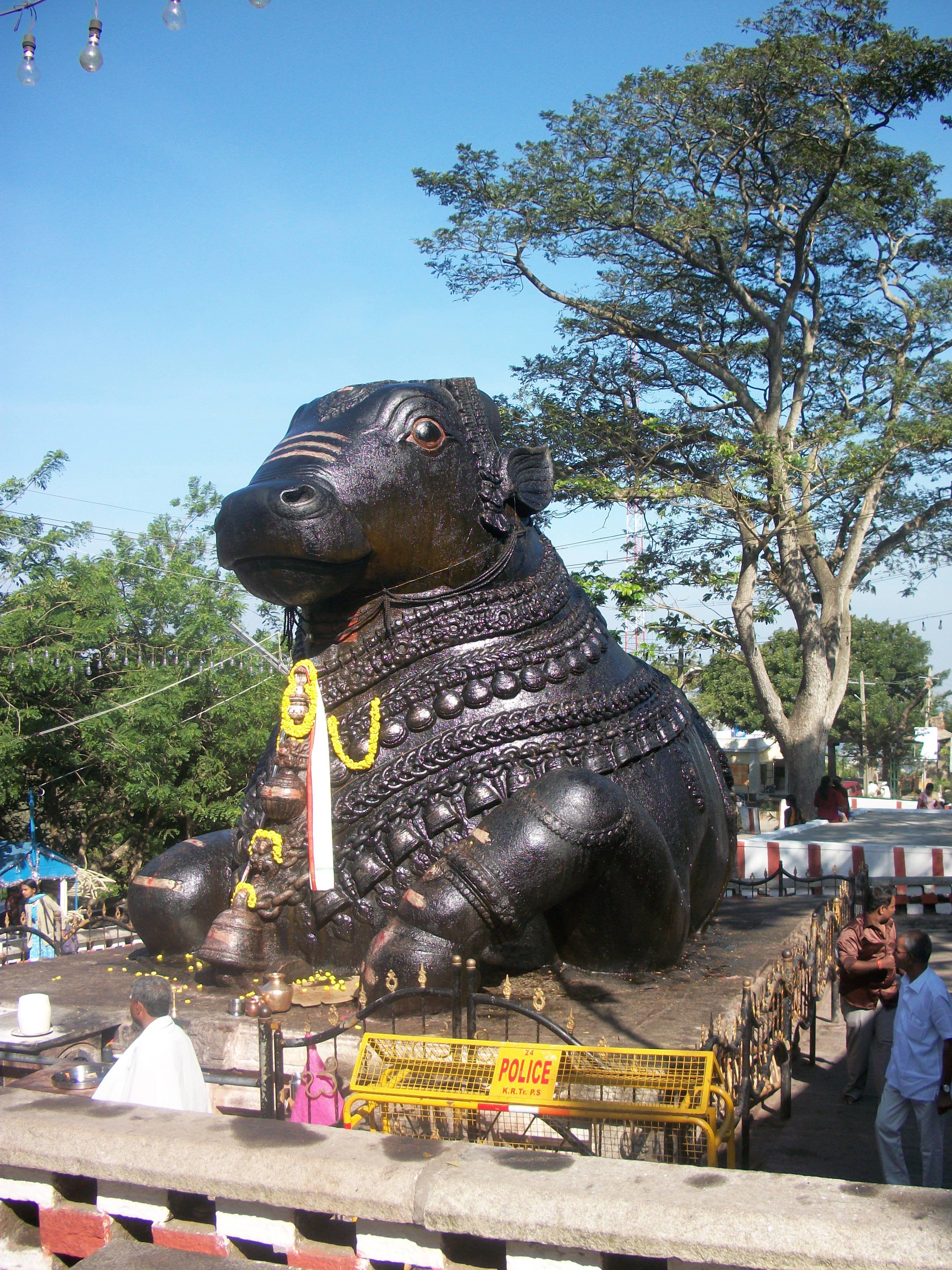 There are many cows in India, but I only saw one bull. His name is Nandi and he is 15 feet tall and 24 feet long. Once you climb 800 of the 1,000 stairs of Chimundi hill you will not miss him. We were told that the monolithic bull had just had his semi-annual oil massage, making it roughly the 700th massage this giant stone-carved creature has received. This black and shiny beast is draped with garlands of flowers and bells. Painted on his forehead are the three white stripes representing devotion to Lord Shiva, his master, who once upon a time used Nandi as his vehicle.
There are many cows in India, but I only saw one bull. His name is Nandi and he is 15 feet tall and 24 feet long. Once you climb 800 of the 1,000 stairs of Chimundi hill you will not miss him. We were told that the monolithic bull had just had his semi-annual oil massage, making it roughly the 700th massage this giant stone-carved creature has received. This black and shiny beast is draped with garlands of flowers and bells. Painted on his forehead are the three white stripes representing devotion to Lord Shiva, his master, who once upon a time used Nandi as his vehicle.
Only a couple hundred more steps to go and we are meeting the rickshaw driver at the top of the hill for the ride back. But first, Kristina had mentioned a temple that she wanted to go 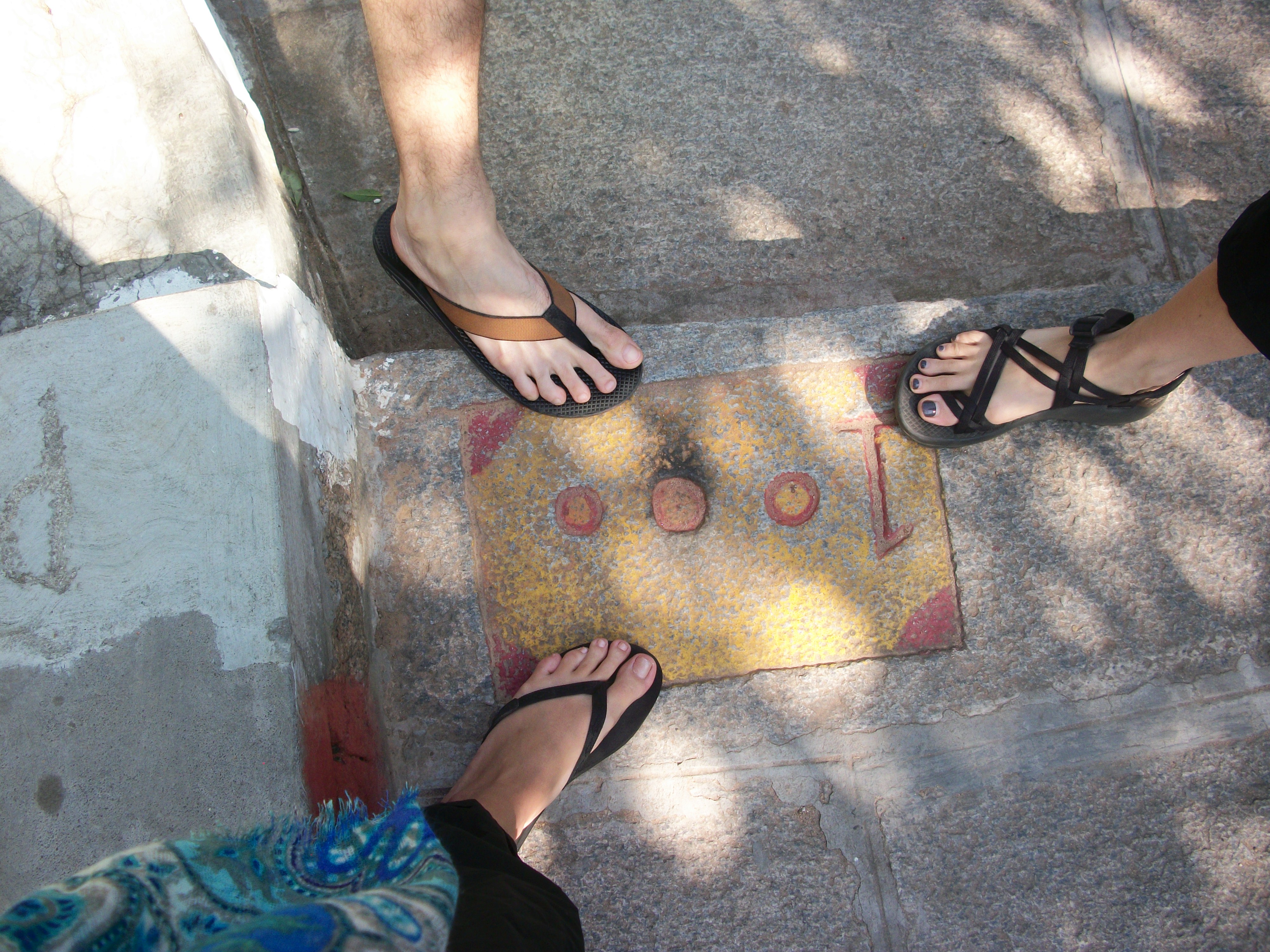 to at the top of the hill, Chimundeshwari Temple. This is my first Hindu temple experience, so of course, I want to go inside. Kristina is much more versed in what one does inside a Hindu temple, so she leads the way as the rest of us follow.
to at the top of the hill, Chimundeshwari Temple. This is my first Hindu temple experience, so of course, I want to go inside. Kristina is much more versed in what one does inside a Hindu temple, so she leads the way as the rest of us follow.
As the four of us walk towards the temple, the carvings on the yellow-colored gopuram, or pyramidal tower, become more visible. There are several devas and devis carved into the sides of the gopuram, which is seven stories and about 130 feet tall.
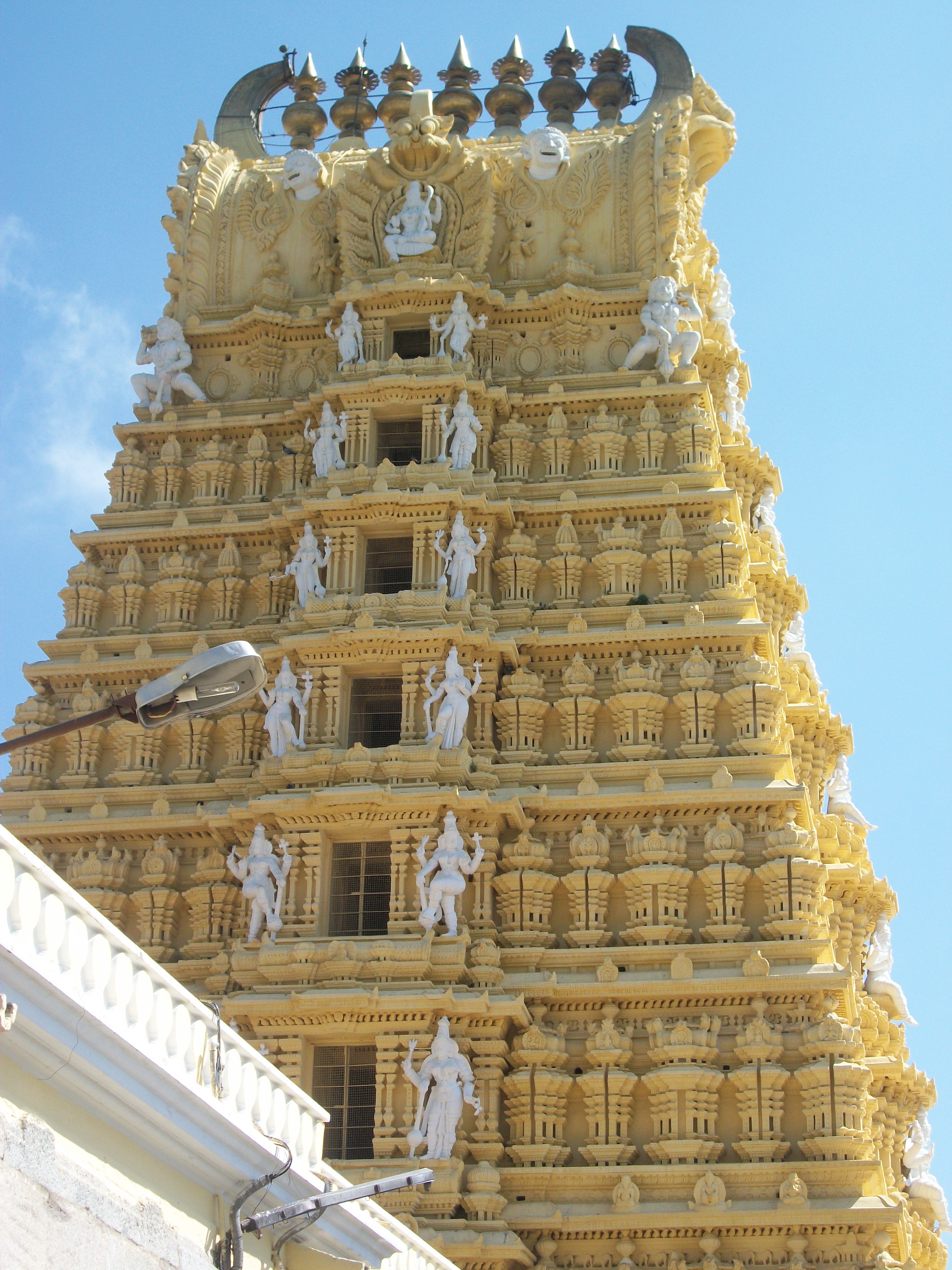 We stop first at a booth outside the temple to get an offering to bring inside. It is here where we also take off our shoes. The offering is a basket filled to the brim with two coconuts, a bunch of bananas, and what looks to me like several yellow carnations, a big
We stop first at a booth outside the temple to get an offering to bring inside. It is here where we also take off our shoes. The offering is a basket filled to the brim with two coconuts, a bunch of bananas, and what looks to me like several yellow carnations, a big 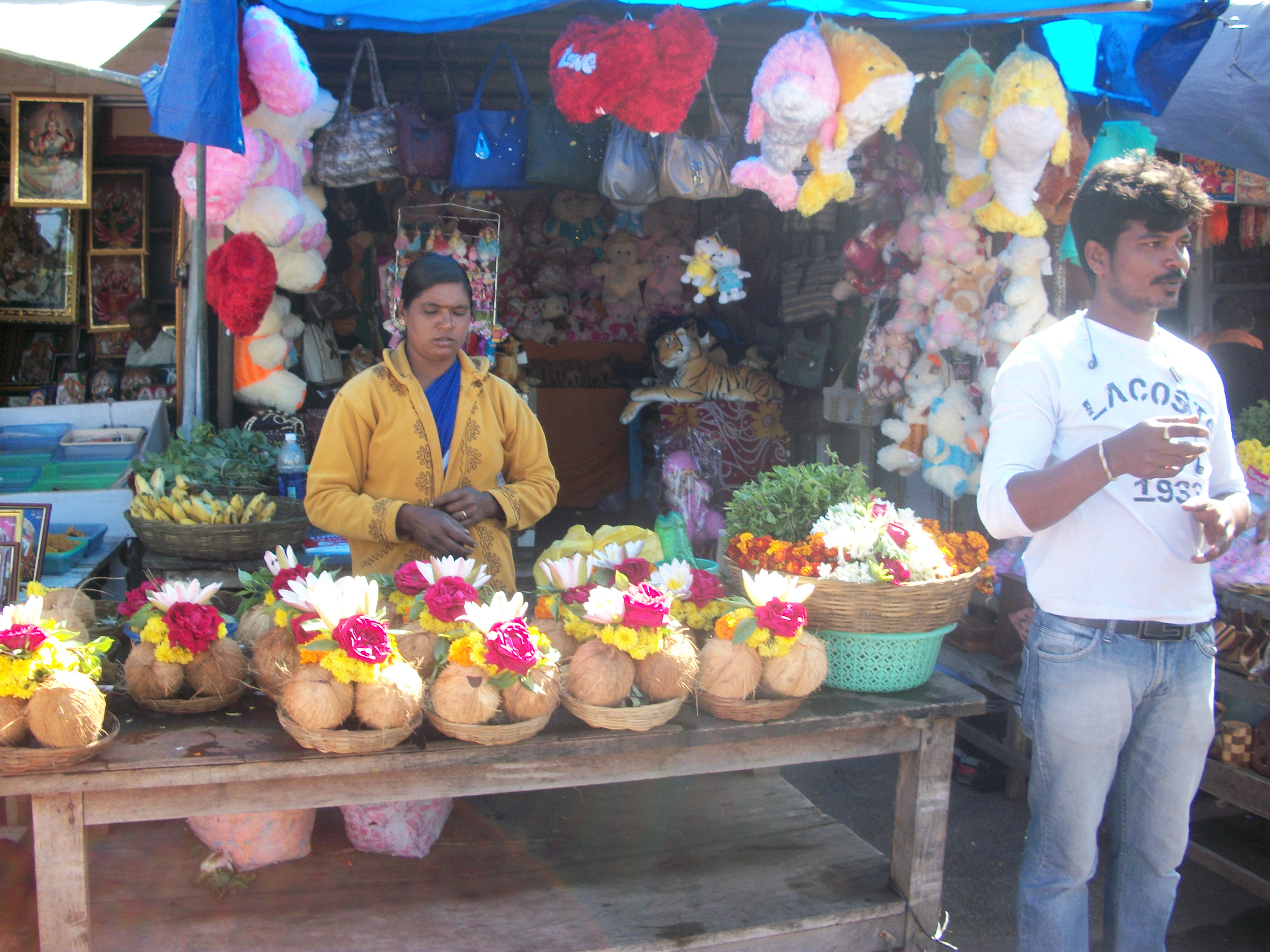 red rose, and a lotus flower. A young boy asks me if I want colors and I am confused
red rose, and a lotus flower. A young boy asks me if I want colors and I am confused
by what he means. I have no idea what he is talking about or what I am supposed to do with my basket of fruit and flowers, let alone some colors, but he drops the small packets on top of my basket anyway. I struggle to keep my overflowing and lopsided basket together, curious as to what I’m going to be doing with it anyway.
As the four of us make our way to the temple we realize there is a long line of people waiting to get inside. There is lots of yelling, or what seems like yelling (in a foreign language) and people are very excited to get inside the temple. People are skipping the line. People are coming back out of the line. It is a bit like being in an amusement park line for a ride; there is a maze of rows to follow. There is much confusion. We are the only white people in the line.
Soon, a man who was working(?) at the temple said we had to go into the temple separately (from the Indians) and that he would show us the way. Why we had to go in separately, I didn’t understand. He warned us to keep our purses and wallets closely guarded. The temple was packed full of people and there were pickpockets, or so he said. I soon realized he would want compensation for guiding us through the temple, and that’s why he wanted us to go in separately. But it felt like a small price to pay to deliver us from mass confusion.
The guide shuffled us through silver-plated doors engraved with more deities and past the small statue of Lord Ganesha, the remover of obstacles. We were packed in tight in front of the shrine, in a crowded room with people leaning over the gates of the inner sanctum to see the solid gold idol of Durga, or Chimundeshwari, the Goddess of power and strength. Though the temple is thought to be built in the 17th century, the shrine may have been built as early as the 11th century.
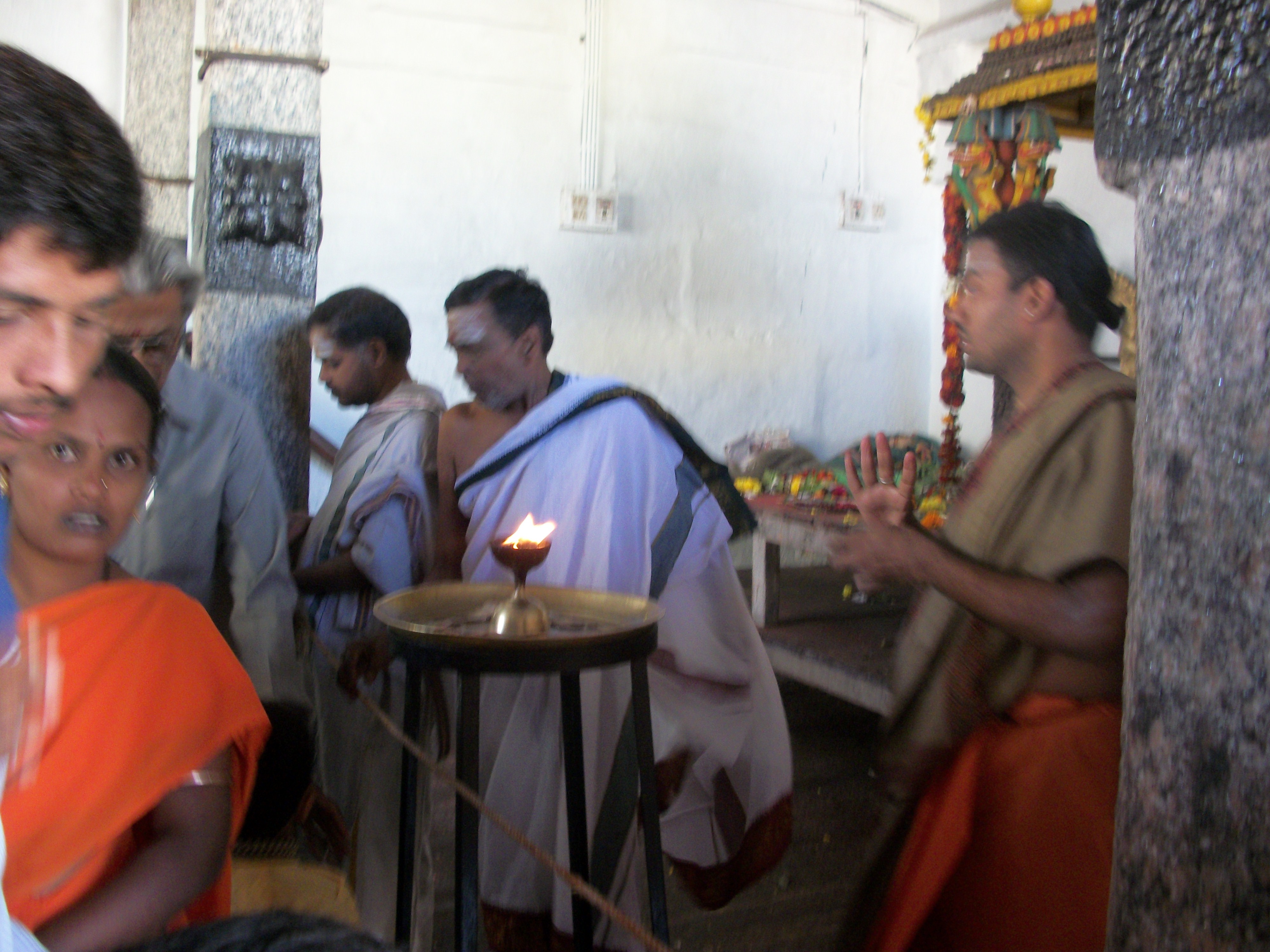 We performed puja here by handing over our offering and were given blessings by the pujari, who marked our foreheads with a red-orange powder called vermilion. We also placed some rupees in the offering dish when the pujari held it in front of us, making sure each of us knew that we were supposed to give them money at this point.
We performed puja here by handing over our offering and were given blessings by the pujari, who marked our foreheads with a red-orange powder called vermilion. We also placed some rupees in the offering dish when the pujari held it in front of us, making sure each of us knew that we were supposed to give them money at this point.
The guide allowed us to take some photographs in certain places, but photos are not allowed inside the temple. There were men wrapped in long white cloth, beads around their neck with markings on their foreheads, some with the same markings as the bull, Nandi. There was oil burning, and flames surrounding the golden idol. We walked along and on another wall, a niched window, or devkoshta, housed another deity. Here a pujari stood blessing people with oil.
We walked outside the temple to get a look at the Vimanam, as it is known in South India, which is the tower rising at the inner sanctum of the temple. At the very top of the Dravidian-style structure, which closely resembles the outer towering gate, there are seven spires pointing to the sky acting as antennas, connecting mortals to the divine.
There was chanting and bells ringing and still, people were being herded through the temple like cattle and I pondered how anyone could possibly have the focus (or space) to pray at this temple.
Just as I was wondering if people actually prayed here or only came by to get a blessing from the pujari, we were given back part of our offerings – the coconuts, which had been cut open, and the bananas and some of the flowers. We took our offerings and sat down on the floor outside the shrine, where we proceeded to eat the fruits and sit quietly to pray, if we wished.
After eating and praying we paid our guide, picked up our shoes, and went to find our rickshaw driver. The boy who had laid the colors in my offering basket spotted us and tried to make me pay for the colors.
Once we found our rickshaw driver, he drove us to Anokhi Garden, a popular restaurant that serves a delicious “Western breakfast”, complete with scrambled eggs and French toast, and French-pressed coffee. After a morning of intensive physical activity we were all starving and it was good to be somewhere that felt familiar again. Kristina tied the flowers from the offering in my hair and I spent the rest of the day with my forehead marked in red with yellow flowers in my hair. I didn’t particularly feel any type of spiritual movement while inside the temple or while climbing the stairs (well, none that I noticed with the commotion of everything else going on, anyway). But still… I couldn’t help but feel blessed, or maybe I should say grateful, on this day – a beautiful, sunny day with new friends and delicious food, and the ability to practice at the shala. 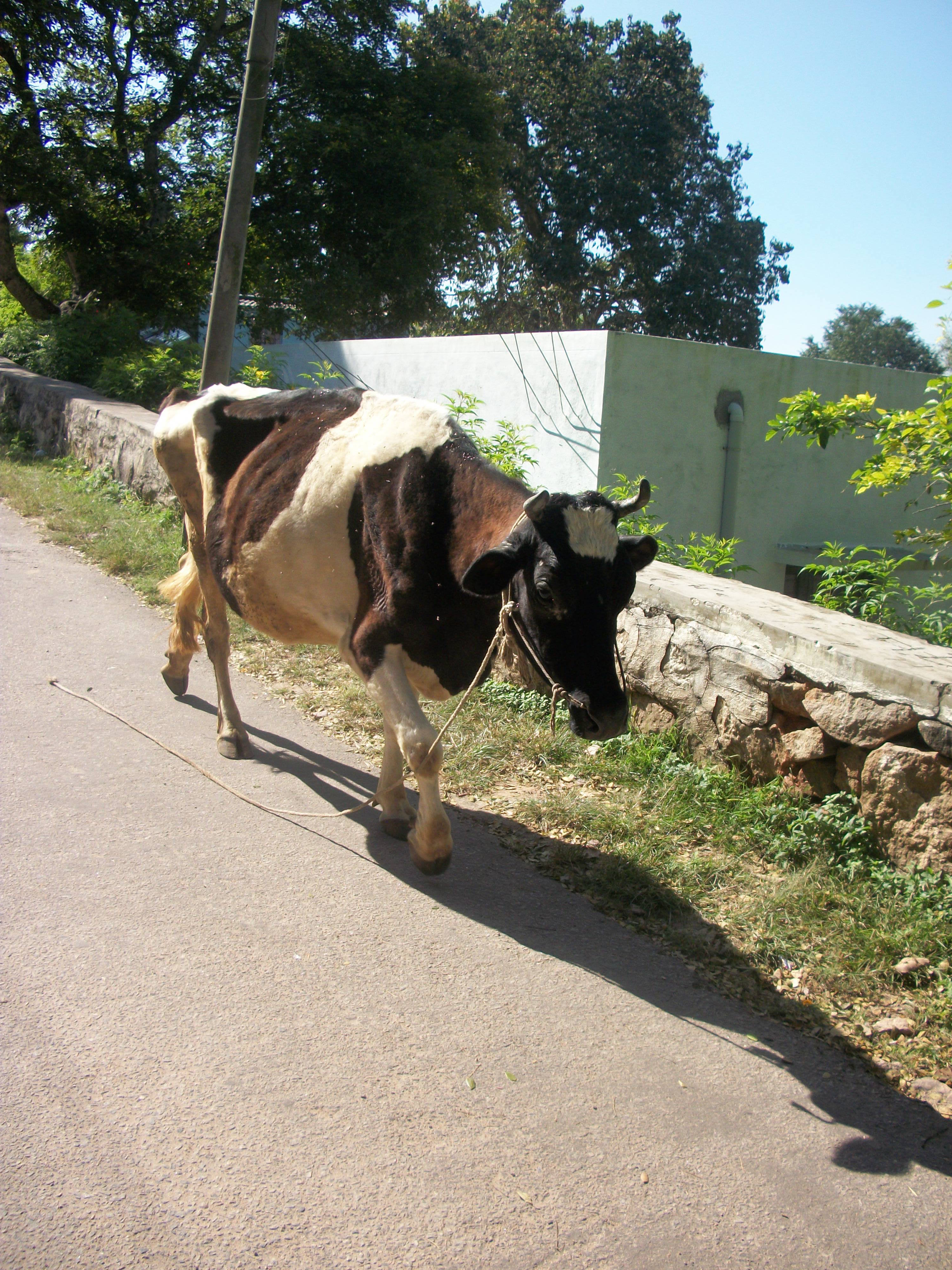
- Does Serving Others Make Us More Humane? - January 12, 2024
- CBD Oil and My Missing Thoughts - October 26, 2023
- How Do We Stay True to Ourselves? - February 26, 2023
